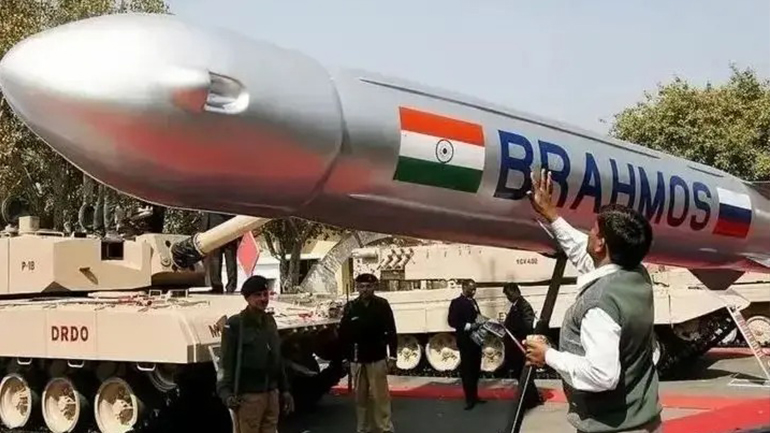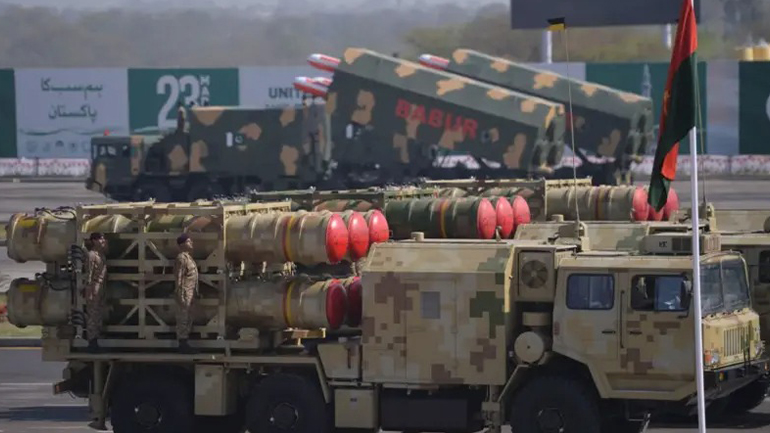

You must be aware of Israel’s well-known air defense systems, such as the "Iron Dome" or "David’s Sling," which are considered advanced missile shields used to intercept incoming threats like rockets and drones. Whether it’s a missile attack from Iran, rockets fired by Hamas, or drones from Houthi rebels, once these objects enter Israeli airspace, they are destroyed mid-air with the help of these automated defense systems. This highlights the importance of a modern air defense system in today’s warfare. In times of war, a country’s air defense system, such as missile tracking radars, anti-aircraft systems, and interceptor technology, becomes extremely important. Along with missile interception systems, this defense also includes radars and other equipment capable of tracking and tracing enemy aircraft and projectiles. On the night between Tuesday and Wednesday, as part of rising India-Pakistan military tensions, India claimed to have carried out attacks at multiple locations in Pakistan and Pakistan-administered Kashmir under Operation Sandhoor, targeting alleged terrorist hideouts. They claimed the operation was in response to the killing of 26 tourists in Pahalgam. According to the Pakistani military, this operation, which lasted from 1:05 AM to 1:30 AM, involved attacks on mosques and civilian areas in Pakistan and its administered Kashmir. Although India did not specify the types of weapons used, Pakistan’s military spokesperson, Lieutenant General Ahmed Sharif Chaudhry, claimed that India carried out a total of 24 attacks at six different locations using various types of weaponry, raising questions about the scale of the cross-border missile strike. In response, Pakistan claimed to have shot down five Indian fighter jets, including a Rafale and a surveillance drone, using its air defense capabilities. This incident echoes a previous event in March 2022, when an Indian BrahMos supersonic missile crashed near Mian Channu, Punjab, further intensifying concerns over the threat of missile misfires in South Asia. India later termed that incident an accident, while Pakistan’s Inter-Services Public Relations (ISPR) stated that the missile was a surface-to-surface supersonic missile capable of traveling at three times the speed of sound. According to military sources, it stayed in Pakistan’s airspace for three minutes and 44 seconds, penetrating 124 kilometers inside Pakistani territory. Pakistan’s air defense forces claim to have been tracking the missile from its launch point in Sirsa, India, yet the question remains: why wasn’t the missile intercepted? With such incidents on the rise, experts are now debating the effectiveness and readiness of Pakistan’s missile defense systems in the face of evolving threats.

Since the Balakot airstrikes in 2019 and the downing of an Indian aircraft by Pakistan, both countries have acquired significant new defense equipment, escalating India-Pakistan military tensions. The Indian Air Force now possesses 36 French-made Rafale fighter jets, which represent a major upgrade in India's aerial combat capabilities. In a recent cross-border airstrike response, the Pakistani military claimed it shot down two Rafale jets in retaliation, although India has not confirmed this claim. According to the International Institute for Strategic Studies, based in London, Pakistan has acquired at least 20 advanced J-10C jets from China during the same period. These aircraft have long-range PL-15 missiles, enhancing Pakistan’s beyond-visual-range combat strength. Regarding missile defense technology, India has procured the Russian-made S-400 missile system, which significantly boosts its strategic air defense. Meanwhile, Pakistan has received the Chinese HQ-9 air defense system, aiming to counter high-altitude threats and cruise missiles. According to Radio Pakistan, the Pakistan Air Force's capabilities have evolved rapidly. Its aerial defense now includes high-to-medium altitude air defense systems, unmanned combat aerial vehicles (UCAVs), advanced aerial platforms, electronic warfare systems, and AI in military defense, highlighting a shift towards tech-integrated warfare. Following the recent Indian missile attack on Pakistani territory, critical questions have emerged: Does Pakistan’s air defense system have the capacity for air defense interception of such threats? And why was it unable to destroy these missiles mid-air before they reached their targets after being launched from Indian airspace?
Former Pakistan Air Force Vice Air Marshal Ikramullah Bhatti, speaking to stated that Pakistan's air defense system can intercept short, medium, and long-range ground-to-ground cruise and ballistic missiles. He mentioned that Pakistan has integrated several missile systems into its defense infrastructure, including the Chinese-made HQ-16FE air defense system, which enables Pakistan to effectively counter ground-launched missiles, cruise missiles, and combat aircraft. However, he clarified that when it comes to intercepting air-to-ground missiles, such a defense system does not currently exist. Former Air Commodore Adil Sultan, in a conversation with noted that no foolproof defense system exists in the world, especially in scenarios involving geographically adjacent countries like Pakistan and India, where borders are often separated by just a few meters. In such situations, it is certainly impossible to intercept every air-to-ground missile attack with 100% success. He explained that every defense system has its limitations. For example, if multiple types of missiles are launched simultaneously from different directions, the system must prioritize which ones it can intercept. Adil Sultan pointed out that following the Balakot incident, Pakistan has significantly enhanced its defense capability by incorporating advanced missile and radar systems. Although these modern systems are highly effective, it is unrealistic to expect that a 2,500+ kilometer-long eastern border can be completely sealed by an air defense system to prevent every missile from crossing. He added that doing so would require billions of dollars, and even then, due to the proximity of the borders, such a system would not be entirely effective. He also claimed that India does not possess such capabilities either. Air Marshal Ikramullah Bhatti said that regarding the incident on the night of May 6, some specific points need to be understood. He suggested that the missiles were likely launched from air-to-ground platforms by India, and such missiles have become highly advanced today. He explained that the speed of these missiles can range from Mach 3 (3,675 km/h) to Mach 9 (11,025 km/h), and intercepting such high-speed weapons is a challenge that even the U.S., Russia, and China currently cannot fully overcome. He also noted that a key difficulty in intercepting air-launched missiles is their very short flight time, leaving little room for reaction. In contrast, ground-to-ground missiles can be intercepted more easily due to their longer flight duration. The former Air Vice Marshal emphasized that India cannot intercept a Pakistani air-to-ground missile if launched toward Indian territory. He reiterated that during the recent incident, Pakistan had very limited time to respond, and the missiles struck within seconds of being fired. Adil Sultan, former Air Commodore of the Pakistan Air Force, reiterated that no defense system in the world can fully prevent attacks from geographically adjacent adversaries. However, such systems can mitigate the damage. He emphasized that the nature of the attack also matters. If air-to-ground missiles are launched simultaneously from multiple directions, radar detection and quick response become more difficult. In contrast, when it comes to ground-launched missiles or cruise missiles, their deployment is generally known, and defense systems can cover their likely flight paths or corridors. He added that, as stated by Pakistan's Foreign Minister Ishaq Dar, around 70 Indian aircraft were involved in the latest attack. In such a large-scale operation, the landing of eight or nine missiles on the ground is not unusual in a wartime context. Although the dropping of these few bombs resulted in loss of life, considering the scale of India’s offensive, some of the attacks were likely decoys, and the impact of these few missiles does not constitute an extraordinary event in military terms.

The Pakistani military has claimed that in response to Indian attacks, the Pakistan Air Force shot down five Indian aircraft and one combat drone. India has not yet confirmed these claims. Speaking on this matter, Air Vice Marshal Ikramullah Bhatti stated that this is a tactical issue, and each air expert might have a different opinion on it. He explained that the situation in aerial combat is quite different from missile attacks. He mentioned that when a country’s air force fires missiles from aircraft at another country, it signals the start of war, and the air force does not stop there but continues to advance, as staying stationary in such circumstances would be highly unwise, especially when enemy aircraft are also in the air. He also pointed out that Indian media reported that Indian aircraft were using flare fire as part of a defensive strategy against Pakistani airstrikes. However, this defensive strategy works when infrared-guided missiles are fired at you from a distance of 15 to 20 kilometers. It does not work against radar-guided missiles. He suggested that India likely underestimated Pakistan’s intention to conduct operations within its airspace. Air Commodore Adil Sultan commented that the conditions of air combat between fighter jets are very different. In systems like ground-to-air or ground-to-ground missiles, you know the missile’s capabilities, the likely launch location, and the possible flight path. However, in aerial combat, you do not know where attacks might come from, and you have to defend yourself from all directions. He added that Pakistan possesses PL-15 air-to-air missiles, which are very advanced weapons obtained from China. These missiles can strike targets at ranges of over 150 kilometers within Pakistan’s airspace and up to 50 kilometers across the border. This capability contributed to the destruction of Indian fighter jets.

Powered by Froala Editor